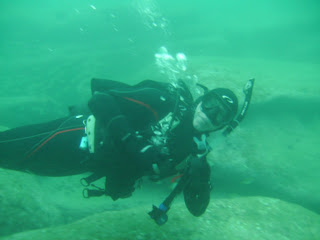On 29 April 1770, Lieutenant James Cook, RN, in HM Bark Endeavour entered Botany Bay and stepped ashore at Kurnell.
Cook and his crew, including the famous scientist Sir Joseph Banks and his assistant Daniel Solander, explored the area of the bay and originally named it Stingray Harbour because of the large number of rays they caught. Cook stayed eight days and then headed north.
Both headlands of Botany Bay are part of Botany Bay National Park. The southern side is known as the Captain Cooks Landing Place section of the national park and is accessed from Captain Cook Drive at Kurnell. A fee is charged to use the park's facilities. There is a monument on the shore to commemorate the landing of Captain Cook and the reef North of this location has become known as The Monument dive site.
This is a really good site if the visibility is good and we were lucky in that the visibility was about as good as it gets at the Monument.
View The Monument in a larger map
The Monument is a very easy dive site, with the relatively longer surface swim being the hardest part. Due to its location right in the bay, viz can be a little worse here than the other sites around Kurnell. But it is still a very nice relaxing dive with usually lots to see. Once you enter the water you snorkel out over kelp in a north easterly direction. There is a red navigation marker out in the bay and if you head towards it you are going in the right direction.
Eastern Frogfish at the Monument
Once you become sick of snorkelling you can descend as sometimes large rays are seen swimming over the kelp. You will be in about 4m of water, keep following your compass till you come to a drop off. Drop over the wall for the main part of the dive. If viz is poor the top of the wall also makes an interesting dive. Swim along with the wall on your right.
Phil and Jess - Sophia and Eric in between dives
Monument's a great dive to take a torch, as they're overhangs hiding blue devil fish, wobbegongs, Port Jacksons, Giant cuttlefish and even the occasional banded coral shrimp.
The Monument entry point
This is a good dive to do as a drift dive if you have an outgoing tide, you can drift from the monument around to Sutherland point or the Steps.When exiting at the Monument make sure you swim up into the channel as there are many sea urchins on the rocks everywhere else.
There are some very timid turtles in the area and here is the proof. This was taken yesterday at the Monument.
Here is a map of the Monument dive site (area in blue on the Google map above) showing the reef, overhangs and surrounding area.
(courtesy of Jemma Donkin)























